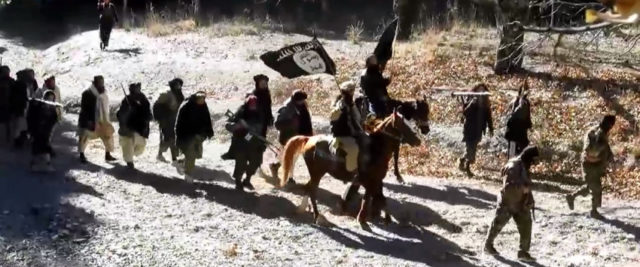
To Afghanistan Not Syria? Islamic State Diverts Tajik Fighters South
Publication: Eurasia Daily Monitor Volume: 14 Issue: 35
By:

In February, the Iranian government extradited five members of the same family originating from Hamadoni district, in southern Tajikistan, back to their home country (Radio Ozodi, March 2). Abdulfayz Vazirov, 33, and his sister Mohira Salimova, 32, left Tajikistan for Russia in the summer of 2016 with her three children. Under the guidance of Abu Nureki, a Tajik fighter in Iraq, they traveled to Turkey. But they could not cross the border with Syria and made their way to Iran instead. Khojaev traveled directly to Iran from Novosibirsk, where he had been working as a mediator on a construction site. The family was detained near Zahedan, in southern Iran, while trying to cross the border into Afghanistan to join the Islamic State Khurasan Province (ISKP)—the local Afghani wing of the international terrorist organization.
This was not an isolated incident. Muhammed Khojaev, 29, from Mastcha, in northern Tajikistan, had crossed the border from Iran into Afghanistan in December 2016 (Radio Ozodi, February 23). As the Islamic State (IS) continues to lose ground in Syria and Iraq, some recruits from Tajikistan are apparently being diverted to fight in Afghanistan—although this is not yet an established conventional militant route.
Hundreds of Central Asians joined the jihad in Afghanistan prior to the 2001 invasion led by the United States. But in recent years, the number of fighters traveling to the region’s southern neighbor reduced to a trickle. Relatively few fighters have been reported in the media or on casualty lists (Afghan Analysts Network, June 27, 2014). In contrast, between 3,000 and 5,000 citizens from Central Asia have traveled to fight in Iraq and Syria since 2013. The Middle Eastern battlefield was more attractive for a number of reasons (Afghan Analysts Network, October 8, 2014). With most recruitment taking place in Russia, where millions of Central Asians work as labor migrants (see EDM, September 9, 2015; September 15, 2015; May 19, 2016), traveling to Syria and Iraq via Iran is easier than crossing the militarized Afghan frontier. Divorced from family and kinship networks, migrants have proved more susceptible to extremist messaging than closely watched communities at home. Thanks to its adept user of social media, the Islamic State was seen as winning when it declared its “caliphate” in June 2014, helping attract more fighters from the region.
But since its peak in the summer of 2014, the Islamic State has lost 62 and 30 percent of its territory in Iraq and Syria, respectively (Twitter.com/coalition, February 11). With the loss of territory has come a sharp drop in income, from an estimated $1.9 billion in 2014, to $870 million in 2016 (Icsr.info, February 17). At the same time, the border with Turkey, the main route for fighters entering the country, has become more difficult to cross. As a result, the number of Central Asians going to fight in the Middle East has decreased in recent years. According to government figures, 1,100 Tajik citizens have traveled to fight in Syria and Iraq. In 2016, according to the Ministry of Interior, just 40 citizens of Tajikistan took this journey, with 80 returning from the battlefield (Radio Ozodi, January 20). The recent cases of Tajiks trying to enter Afghanistan (see above) appear to be a product of this decline of the Islamic State’s fortunes in Syria and Iraq.
Having declared itself in January 2015, the ISKP has struggled to make inroads in Afghanistan. Estimates of the number of militants fighting with the Afghan wing of the Islamic State vary. Last year, Russian Deputy Foreign Minister Grigory Karasin put the number at 6,000, but other experts have provided a more circumspect figure—2,500 (24News, July 4, 2016; Usip.org, April 7, 2016). ISKP is based in Nangarhar province, on the border with Pakistan, but has claimed responsibility for a string of attacks in Kabul (Afghan Analysts Network, July 27, 2016). Like their comrades in Syria and Iraq, fighters for the ISKP have suffered heavy casualties in recent months, losing 497 members in the final quarter of 2016, according to one report (Religionandgeopolitics.org [London], January 20). A number of Tajikistanis and Uzbekistanis are already fighting with the ISKP. But their strength is still unknown. Many joined in July 2015, when the Islamic Movement of Uzbekistan (IMU) swore allegiance to the ISKP (Furqon TV, July 31, 2015). The presence of ethnic-Tajik, -Uzbek and -Turkmen communities in northern Afghanistan has confused the process of identifying foreign fighters, with officials often describing Afghan citizens as “Tajik” or “Uzbek.” Given this tendency, the precise number of fighters in Afghanistan from post-Soviet Central Asia in fact is likely to be minimal.
Although a few Tajikistani citizens have attempted the Russia–Iran–Afghanistan route, ostensibly on orders from the Islamic State, the pathway is not yet fully established. More Central Asians can be expected to attempt that journey, but their success will depend on how tightly the Iranian government controls the border. The interdiction of one group trying to cross the border in February indicates a willingness on the part of the Iranian authorities to halt militant traffic. In summary, the diversion of Tajik recruits from Syria and Iraq to Afghanistan is a sign of the Islamic State’s overall weakness rather than its strength. Given the group’s numerous setbacks, the IS’s recruitment rates are unlikely to return to their 2014 levels. Meanwhile, a few extra Central Asian militants will not tip the balance in ISKP’s favor in Afghanistan.



